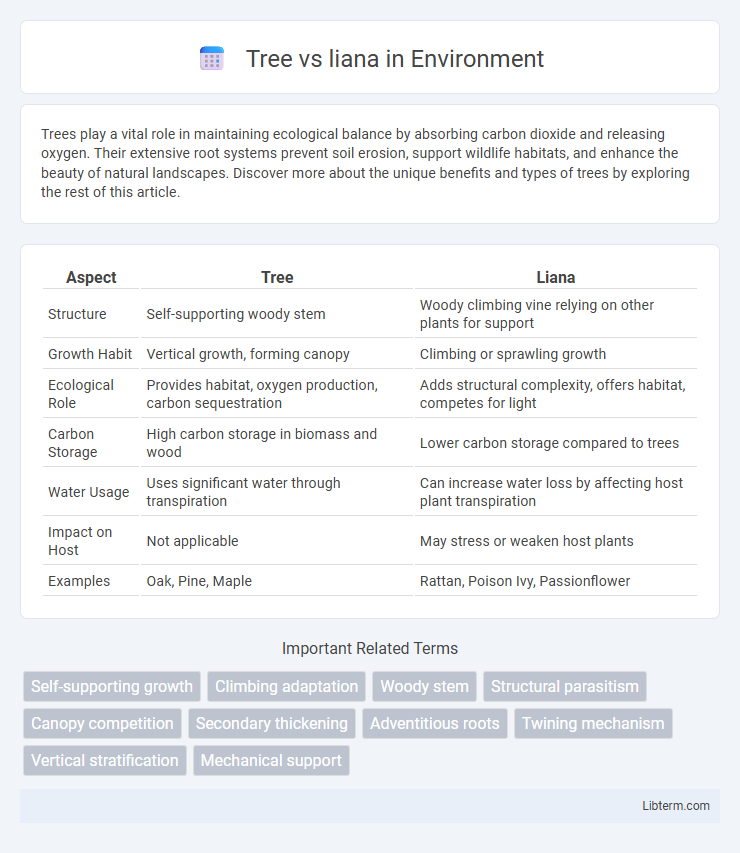Trees play a vital role in maintaining ecological balance by absorbing carbon dioxide and releasing oxygen. Their extensive root systems prevent soil erosion, support wildlife habitats, and enhance the beauty of natural landscapes. Discover more about the unique benefits and types of trees by exploring the rest of this article.
Table of Comparison
| Aspect | Tree | Liana |
|---|---|---|
| Structure | Self-supporting woody stem | Woody climbing vine relying on other plants for support |
| Growth Habit | Vertical growth, forming canopy | Climbing or sprawling growth |
| Ecological Role | Provides habitat, oxygen production, carbon sequestration | Adds structural complexity, offers habitat, competes for light |
| Carbon Storage | High carbon storage in biomass and wood | Lower carbon storage compared to trees |
| Water Usage | Uses significant water through transpiration | Can increase water loss by affecting host plant transpiration |
| Impact on Host | Not applicable | May stress or weaken host plants |
| Examples | Oak, Pine, Maple | Rattan, Poison Ivy, Passionflower |
Introduction to Trees and Lianas
Trees are tall, woody plants with a single main stem called a trunk, supporting branches and leaves that form a canopy vital for ecosystems. Lianas are climbing or trailing woody vines that rely on trees for structural support to reach sunlight in dense forests. Both play crucial roles in forest ecology, with trees providing habitat and lianas enhancing biodiversity and forest dynamics.
Key Differences Between Trees and Lianas
Trees are woody plants with a single main trunk that supports a self-standing structure, allowing them to grow tall and develop extensive canopies. Lianas are long-stemmed, woody vines that rely on other plants, typically trees, for support, using their flexibility to climb toward sunlight in forest environments. Unlike trees, lianas invest less in structural tissues and more in rapid vertical growth, affecting their ecological roles and life strategies in tropical ecosystems.
Growth Forms and Structures
Trees exhibit a self-supporting growth form with robust trunks formed by secondary growth from vascular cambium, providing rigidity and height. Lianas, in contrast, are woody vines that rely on other structures for physical support and develop flexible, elongated stems to climb toward sunlight. The structural differences reflect their ecological strategies: trees invest in strong, autonomous architecture, while lianas maximize height gain with minimal biomass by leveraging host plants.
Ecological Roles of Trees vs. Lianas
Trees provide essential structural support and habitat for diverse wildlife, contributing significantly to carbon sequestration and climate regulation. Lianas, as woody vines, enhance forest dynamics by linking tree canopies, facilitating animal movement, and increasing biodiversity through their unique interactions with arboreal species. Together, trees and lianas maintain forest ecosystem balance, influencing nutrient cycling, light penetration, and overall habitat complexity.
Adaptations for Survival
Trees develop thick bark and deep root systems to withstand harsh weather and obtain water from deeper soil layers. Lianas adapt by relying on structural support from host trees, allowing them to allocate more energy to rapid vertical growth and leaves for photosynthesis. This climbing strategy helps lianas compete for light in dense forests while minimizing investment in supportive tissues.
Impact on Forest Dynamics
Trees anchor forest structure by providing vertical complexity and habitats for diverse species, significantly influencing light penetration and nutrient cycling. Lianas, as woody vines, compete aggressively with trees for sunlight and water, often reducing tree growth and survival rates. Their presence alters forest dynamics by increasing tree mortality and shaping species composition, ultimately affecting carbon storage and forest regeneration processes.
Reproductive Strategies
Trees primarily rely on wind, insects, or animals to disperse pollen and seeds, ensuring genetic diversity and successful reproduction across distances. Lianas often utilize similar pollination methods but may also exploit their climbing habit to reach sunlight and attract pollinators more effectively. The reproductive success of lianas depends on their ability to allocate resources between climbing growth and flower or fruit production, balancing structural support and reproduction.
Economic and Cultural Importance
Trees contribute significantly to global economies by providing timber, fruits, and medicinal products essential for industries such as construction, pharmaceuticals, and agriculture. Lianas, though less commercially exploited, support biodiversity by connecting forest canopies and are culturally important in many indigenous traditions for crafting tools, ropes, and traditional medicines. Both trees and lianas play vital roles in sustaining ecological balance and local economies through diverse ecosystem services and cultural practices.
Conservation Concerns and Challenges
Trees and lianas face distinct conservation concerns, with trees often threatened by deforestation and habitat fragmentation, leading to significant losses in biodiversity. Lianas, which depend on trees for structural support, are vulnerable to changes in forest composition and canopy structure caused by logging and land-use change. Conservation efforts must address the interdependence between trees and lianas, emphasizing habitat preservation and sustainable forest management to maintain ecosystem integrity.
Future Perspectives on Trees and Lianas
Future perspectives on trees and lianas emphasize their distinct ecological roles in forest dynamics and carbon sequestration processes. Trees typically store more biomass and provide structural support for ecosystems, while lianas, as climbing woody vines, influence tree growth and forest canopy interactions by competing for light and nutrients. Understanding the balance between tree and liana proliferation is critical for modeling forest resilience and mitigating climate change impacts in tropical and temperate regions.
Tree Infographic

 libterm.com
libterm.com